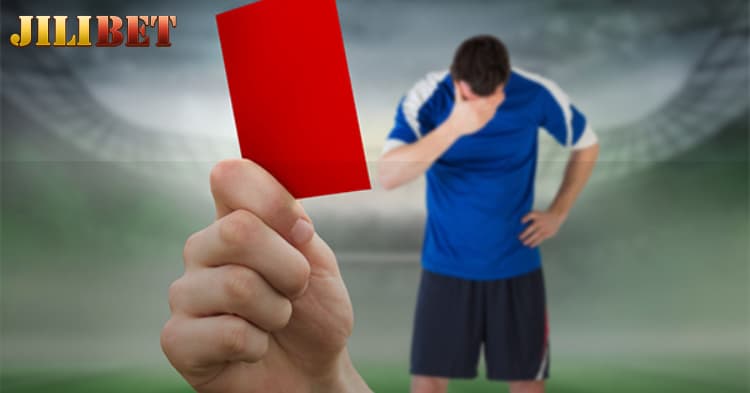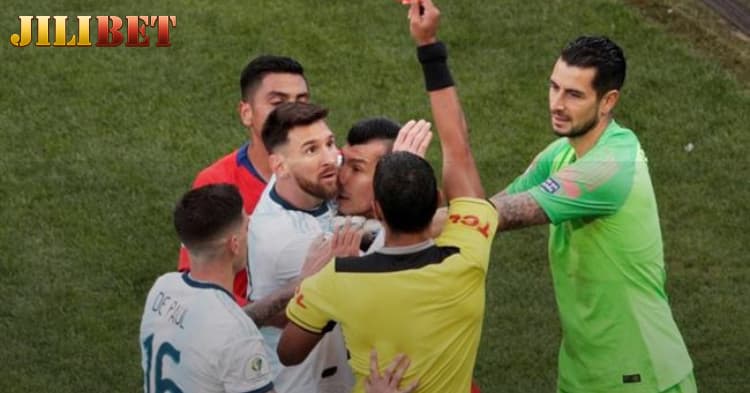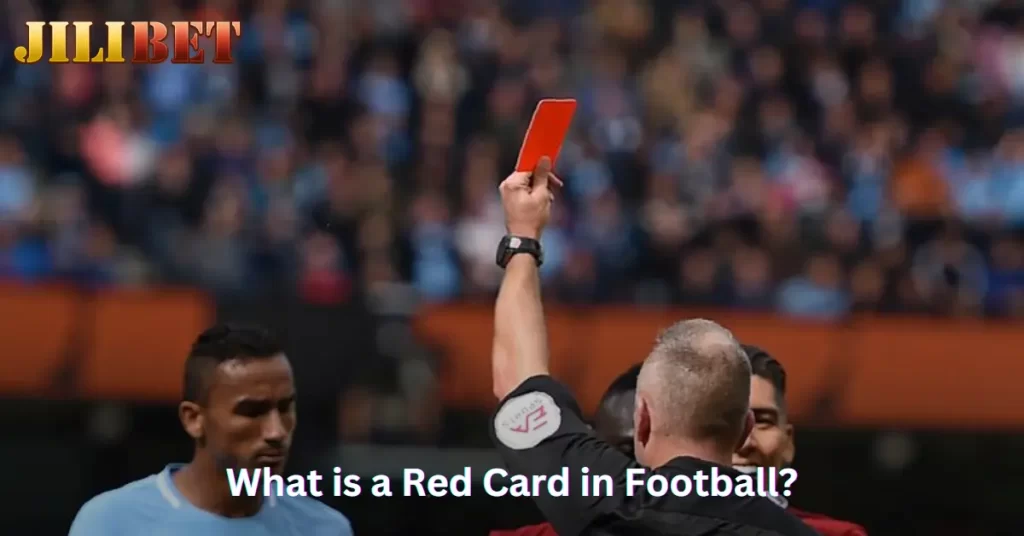A player who receives a red card in football may be suspended for one match or even up to three matches, depending on the severity of the offense.
Red cards are undoubtedly familiar to football enthusiasts. But do you know when red cards were introduced? Or why football even has red cards? Let’s Jilibet explore the Red Card in football together in this article.
What is a Red Card in Football?
Like in basketball, in football, yellow cards and red cards are used to discipline players for improper conduct during a match. A player who receives a red card is immediately sent off the field and barred from participating for the remainder of the game. They will also face suspension starting from the next match.

This leaves the team at a disadvantage, playing with only ten players, thereby giving the opposing team a significant edge.
- Yellow Cards:
Yellow cards serve as warnings for reckless or unintentional acts of aggression without immediate penalties. - Two Yellow Cards Equal One Red Card:
A player who receives two yellow cards in the same match is shown a red card and sent off. - Suspension Rules:
Players dismissed for receiving a red card are suspended for a certain number of matches, with the length of suspension depending on the severity of the offense.
Additionally, accumulating too many yellow cards across different matches in a season can lead to suspension, as determined by the governing body of the league or tournament. - Specific Offenses:
If a player receives two yellow cards (resulting in a red card), they are typically suspended for the next match in the same competition.
Racist behavior results in longer suspensions, often exceeding three matches.
Spitting at someone can lead to an automatic six-match suspension.
The Origin of the Red Card in Football
The red card was invented in 1966 by Ken Aston, who served as the refereeing supervisor during that year’s World Cup. The context was the global nature of the tournament, where language barriers posed a significant challenge for referees.
Ken Aston noticed instances where players and spectators struggled to understand the referee’s decisions. To address this, he devised the card system we are familiar with today. The system was first implemented during the 1970 World Cup and has since become a staple in football, as well as in many other sports.
What Offenses Warrant a Red Card in Football?
- Committing a serious foul.
- Engaging in violent conduct.
- Spitting at another person.
- Denying the opposing team an obvious goal-scoring opportunity by deliberately handling the ball.
- Denying an obvious goal-scoring opportunity to an opponent moving toward the goal through a foul that warrants a free kick or penalty.
- Using offensive, insulting, or abusive language and/or gestures.
- Receiving a second yellow card in the same match.
What Happens When a Goalkeeper Receives a Red Card in Football?
If a goalkeeper is shown a red card, the same rules apply as with any other player—they are sent off the field.
- The team is reduced to 10 players, and a substitute goalkeeper must come on to replace the sent-off goalkeeper, which requires an adjustment in the team’s formation.
- If the team has already used all three substitutions at the time of the red card, the coach must assign one of the outfield players to act as a temporary goalkeeper.
Although not an ideal situation, this has happened in the past. For example, when Pepe Reina was sent off during a Liverpool match against Newcastle in 2012, Liverpool had already used all their substitutions. As a result, defender Jose Enrique was forced to wear the goalkeeper’s gloves for the remainder of the match.
=> Read more: Effective Basketball Betting Strategies and Mistake You Should Avoid
Does a Red Card Lead to a Penalty Kick for the Opposing Team?
A penalty kick is awarded to the opposing team when a player commits one of the ten direct free-kick offenses inside their own penalty area while the ball is in play. If the penalty kick results in the ball entering the goal, it is counted as a valid goal. For penalty kicks awarded during the last minutes of either half or extra time, additional time is allowed to complete the kick.
Direct Free Kick Offenses Leading to a Penalty Kick

The opposing team will receive a direct free kick if a player commits any of the following six offenses, provided the referee deems the action careless, reckless, or excessively forceful:
- Kicking or attempting to kick an opponent.
- Tripping or attempting to trip an opponent.
- Jumping at an opponent.
- Charging an opponent.
- Striking or attempting to strike an opponent.
- Pushing an opponent.
Additionally, the opposing team will be awarded a direct free kick for these four offenses:
- Tackling an opponent to gain possession of the ball but making contact with the opponent before the ball.
- Holding an opponent.
- Spitting at an opponent.
- Deliberately handling the ball (except for the goalkeeper within their penalty area).
The direct free kick is taken from the spot where the offense occurred.
If any of these ten direct free-kick offenses occur within a team’s penalty area while the ball is in play, a penalty kick is awarded regardless of the ball’s position at the time of the foul.
=> Read more: Bet on Both Teams to Score – Best Tip for Success.
How a Penalty Kick is Taken
Positioning of the Ball and Players
- Ball: The ball must be placed directly on the penalty mark.
- Players:
- The penalty taker: Must be clearly identified.
- Goalkeeper of the defending team: Must remain on the goal line between the goalposts, facing the kicker until the ball is kicked.
- Other players: Must remain on the field of play but outside the penalty area, behind the penalty mark, and at least 9.15 meters (10 yards) from the penalty mark.
The referee will only signal for the penalty kick to be taken once all players are positioned correctly as required by the rules.
Penalty Kick Procedure
- The penalty taker must kick the ball forward.
- The kicker can only touch the ball a second time once it has been touched by another player.
- The ball is in play when it has been kicked and clearly moves forward.
If the penalty kick is taken during additional time at the end of either half, a goal will be awarded if the ball crosses the goal line between the posts and beneath the crossbar, even if it first strikes the posts, crossbar, or goalkeeper.
=> Read more: Expert Tips for Predicting Football Scores Accurately
Violations During a Penalty Kick
- If the kicker violates the rules:
- If the ball enters the goal, the kick is retaken.
- If the ball does not enter the goal, play resumes with an indirect free kick for the opposing team.
- Other examples of violations:
- Players encroaching into the penalty area before the kick is taken.
- The goalkeeper moving off the goal line too early.
In such cases, the referee’s decision will vary depending on the outcome of the penalty kick and the nature of the violation.
=> Are you looking for a reputable and top-quality casino for betting? Try our partners: Phwin.
Summary
We hope that the information shared by Jilibet in this article has helped you better understand the significance of yellow and red cards in football. For more exciting insights about the world’s most popular sport, visit www.jilibet.com.ph now!

Launched in 2017, JILIBET began its odyssey, serving the Philippines entertainment and gambling. JULIET is a Filipino-owned corporation – Ms.Carmen Dela Rosa, the CEO of Jilibet Casino, is a visionary leader who has been instrumental in driving the brand’s growth since its founding.

